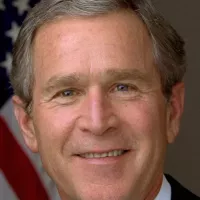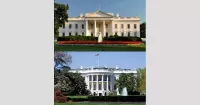The Medal of Honor (MOH) is the highest US military decoration, awarded to members of the Armed Forces for valor in action. Presented "in the name of the United States Congress," usually by the president, it recognizes extraordinary acts of courage and self-sacrifice. While sometimes called the Congressional Medal of Honor, its official name is simply "Medal of Honor."
1904: Army Medal of Honor Redesign
In 1904, General George Lewis Gillespie redesigned the planchet of the Army's version of the Medal of Honor to distinguish it from other medals.
1904: Army 'Gillespie' Medal of Honor Version Introduced
In 1904, the Army "Gillespie" version of the Medal of Honor introduced a smaller redesigned star and the ribbon was changed to the light blue pattern with white stars seen today. The 1904 Army version also introduced a bar with the word "Valor" above the star.
1913: Naval Medal of Honor Adopts New Ribbon Pattern
In 1913, the Naval version of the Medal of Honor adopted the same ribbon pattern as the Army version.
1914: Smedley Butler's First Medal of Honor
In 1914, Smedley Butler received one of his two Medals of Honor.
1915: Smedley Butler's Second Medal of Honor
In 1915, Smedley Butler received his second Medal of Honor.
1916: Congress Establishes Medal of Honor Review Board
In 1916, Congress established the Medal of Honor Review Board.
1916: Convening of the Medal of Honor Review Board
In 1916, a board of Army generals convened to review every Army Medal of Honor awarded, focusing on awards not given for distinguished conduct in action against an enemy.
1917: Medals Stripped from Army's Medal of Honor List
In 1917, based on the Medal of Honor Review Board's report established by Congress in 1916, 911 recipients were stricken from the Army's Medal of Honor list due to inappropriate awarding, including William Frederick "Buffalo Bill" Cody and Mary Edwards Walker.
1917: Restoration of Awards
In 1917, five recipients whose names were included on the Army's medal revocations had their awards restored.
1917: Army Medals of Honor Revoked After Review
In 1917, following a review authorized by Congress, 911 Army Medals of Honor were revoked due to inappropriate awarding.
1917: Medal of Honor Board Revoked Awards
In 1917, the Medal of Honor Board revoked 911 awards, impacting 910 names on the Army's Medal of Honor list, including Mary Edwards Walker and William F. "Buffalo Bill" Cody. However, none of the recipients were ordered to return their medals.
1917: Medal of Honor Review Board Report
In 1917, the Medal of Honor review board issued its report which was reviewed by the Judge Advocate General, who advised against seeking the return of revoked medals.
October 3, 1918: John J. Kelly Awarded Two Medals of Honor
On October 3, 1918, John J. Kelly was the last living individual to be awarded two Medals of Honor.
1918: Laws Passed for the Army
In 1918, laws were passed for the Army which stipulated that "no more than one medal of honor . . . shall be issued to any one person,"
1918: Army Medal of Honor Statute
In 1918, the governing statute for the Army's Medal of Honor (10 U.S.C. § 6241) explicitly stated that a recipient must be "an officer or enlisted man of the Army," "distinguish himself conspicuously by gallantry and intrepidity at the risk of his life above and beyond the call of duty," and perform an act of valor "in action involving actual conflict with an enemy,"
1919: Laws Passed for the Navy
In 1919, laws were passed for the Navy which stipulated that "no more than one medal of honor . . . shall be issued to any one person,"
1919: Navy Introduces Combat and Non-Combat Versions of Medal of Honor
In 1919, the Department of the Navy decided to separate the Medal of Honor into two versions: one for combat and one for non-combat. The Tiffany Company designed a new pattern of the medal pendant, in cross form.
1926: Air Corps Authorization
In 1926, the Air Corps was authorized by statute on Jul. 2, giving the Air Force retroactive jurisdiction over military awards to that date, despite the Air Force not existing as a separate service then.
1926: Tiffany Cross Awarded for North Pole Flight
In 1926, the Tiffany Cross was awarded to Navy CDR Richard E. Byrd and Floyd Bennett for their flight to the North Pole, despite the "actual conflict" guidelines.
1927: Executive Order Issued by President Coolidge
In 1927, President Coolidge issued an executive order that forbade issuing more than one federal decoration for the same action.
1930: Byrd Requests Alternate Medal Version
In 1930, Byrd requested the alternate version of the medal from President Herbert Hoover.
1941: Posthumous Medal of Honor Awards
Since 1941, more than half of the Medals of Honor have been awarded posthumously.
1942: Navy Returns to Original Medal Design
In 1942, in response to a lawsuit, the Department of the Navy requested an amendment to expressly allow noncombat awards of the Medal of Honor. When the amendment passed, the Department of the Navy returned to using only the original 1862 inverted 5-point star design and retired the Tiffany Cross.
1944: Suspension Ribbons Replaced
In 1944, the suspension ribbons for both versions of the Medal of Honor were replaced with the now-familiar neck ribbon.
1944: Medal of Honor Attached to Neck Ribbon
Since 1944, the Medal of Honor has been attached to a light blue colored moiré silk neck ribbon that is 1+3⁄16 in (30 mm) in width and 21+3⁄4 in (550 mm) in length.
September 19, 1947: Air Force Establishment
The number of Air Force Medal of Honor recipients does not count recipients from its pre-September 19, 1947, Army-related predecessor organizations.
1956: Air Force Medal of Honor Authorized
In 1956, a separate design for a version of the medal for the Department of the Air Force was authorized.
1963: Coast Guard Medal of Honor Authorized
In 1963, a separate Coast Guard Medal of Honor was authorized, though it was never designed or awarded.
April 14, 1965: Design of Air Force Medal of Honor
On April 14, 1965, the design for the Department of the Air Force version of the Medal of Honor was finalized.
1965: Air Force Receives Distinctive Medal of Honor
In 1965, the Air Force received its own distinctive version of the Medal of Honor, differing from the Army's version which they had previously used. The design was finalized on April 14, 1965.
1965: Air Force Version Design
In 1965, when the Air and Space Force's version of the medal was designed, it incorporated similar elements and design from the Army version. The new medal depicted the Statue of Liberty's image in place of Minerva on the medal and changed the connecting device from an eagle to Jupiter's thunderbolt flanked with wings.
January 1967: First Air Force Medal of Honor Awarded
In January 1967, the first Medal of Honor specifically designed for the Department of the Air Force was awarded.
1977: Medal Restored Posthumously
In 1977, Mary Edwards Walker's Medal of Honor was restored posthumously by the Army's Board for Correction of Military Records, although this action is often misattributed to President Jimmy Carter.
1977: Walker's Medal Restored
In 1977, Mary Edwards Walker's medal was restored by the Army Board for Correction of Military Records.
1977: Mary Edwards Walker's Medal Restored
In 1977, the Army's board for correction of military records unilaterally restored Mary Edwards Walker's Medal of Honor at the request of a relative.
1980: Presidential Decoration of Medal of Honor Recipients
Since 1980, nearly all Medal of Honor recipients—or in the case of posthumous awards, the next of kin—have been personally decorated by the president.
June 12, 1989: Medals Reinstated for Cody and Other Civilian Scouts
On June 12, 1989, the Army's board for correction reinstated the medals for Cody and four other civilian scouts after a relative of Cody's requested the same action from the Army's board for correction, following Walker's restoration.
1989: Medals Restored for Cody and Other Scouts
In 1989, Buffalo Bill Cody and four other civilian scouts had their medals restored by the Army Board for Correction of Military Records.
1989: Restoration of Medals of Honor
In 1989, the Army Board for Correction of Military Records restored the Medals of Honor of Buffalo Bill and four other civilian scouts.
1990: Medal of Honor Day designated
In 1990, Congress designated March 25 as Medal of Honor Day, to honor recipients of the Medal of Honor.
1993: Study on Racial Disparity
In 1993, a U.S. Army study investigated "racial disparity" in the awarding of medals, finding that no Medals of Honor had been awarded to U.S. soldiers of African descent who served in World War II at the time.
January 13, 1997: Medal of Honor Presented to World War II Veterans
On January 13, 1997, President Bill Clinton presented the Medal of Honor to seven World War II veterans, six posthumously, based on the 1993 study's recommendations.
1998: Study of Asian Americans
In 1998, a similar study of Asian Americans resulted in forwarding at least 47 cases of Distinguished Services Crosses for potential upgrade, as well as one Silver Star.
2000: Medals of Honor Presented to Asian Americans
In 2000, following a historical review, President Clinton presented 22 Medals of Honor to Asian Americans, including 20 to U.S. soldiers of Japanese descent from the 442nd Regimental Combat Team.
2001: Theodore Roosevelt Awarded Medal of Honor
In 2001, Theodore Roosevelt was posthumously awarded the Medal of Honor.
2001: Medal of Honor Flag Concept
In 2001, retired U.S. Army Special Forces First Sergeant Bill Kendall designed a flag to honor Medal of Honor recipient Army Air Forces Captain Darrell Lindsey, inspiring the Medal of Honor Flag.
October 23, 2002: Medal of Honor Flag Authorized
On October 23, 2002, Pub. L. 107–248 was enacted, authorizing a Medal of Honor Flag to be presented to each person to whom a Medal of Honor is awarded.
2004: Bill Considered to Change Medal Composition
In 2004, the United States Congress considered a bill that would require the Medal of Honor to be made with 90% gold, but the measure was dropped.
April 4, 2005: First Medal of Honor Flag Presentation
On April 4, 2005, President George W. Bush presented the Medal of Honor and Flag to the family of U.S. Army Sergeant First Class Paul R. Smith during the award ceremony for him in the White House. Smith was the first Medal of Honor Flag recipient and received the flag posthumously.
2005: Medal of Honor Presented to Tibor Rubin
In 2005, President George W. Bush presented the Medal of Honor to Tibor Rubin, a Hungarian-born American Jew and Holocaust survivor, for his service in the Korean War.
September 2006: Special Medal of Honor Flag Presentation Ceremony
In September 2006, a special Medal of Honor Flag presentation ceremony was held for over 60 living Medal of Honor recipients on board the USS Constitution.
2010: Congressional Direction for Award Review
In 2010, Congress directed the Department of Defense to survey military leaders regarding potential downgrading of valor awards.
2011: DoD Instructions Amended Regarding Medal of Honor
In 2011, Department of Defense instructions were amended to allow for additional Medal of Honor ribbons or a "V" device for subsequent acts justifying the award. The Medal of Honor was the only decoration authorized to use the "V" device.
April 11, 2013: Medal of Honor Presented to Emil Kapaun
On April 11, 2013, President Obama posthumously presented the Medal of Honor to Army chaplain Captain Emil Kapaun for his actions as a prisoner of war during the Korean War.
March 18, 2014: Upgrading of Distinguished Service Crosses to Medals of Honor
On March 18, 2014, President Obama upgraded Distinguished Service Crosses to Medals of Honor for 24 Hispanic, Jewish, and black individuals for their actions in World War II, the Korean War, and the Vietnam War.
July 2014: DoD Instructions Changed
In July 2014, DoD instructions were changed to mandate that a separate Medal of Honor be presented for each succeeding act that justified the award, removing the authorization for the "V" device.
2014: Further Congressional Direction for Award Review
In 2014, Congress again directed the Department of Defense to review the Medal of Honor process to ensure fairness and timeliness.
2015: Litigation over the Garlin Conner award
In 2015, Subsequent litigation over the Garlin Conner award, which was recommended by the Army's board for correction of military records established that the correction boards lack the authority to unilaterally award Medals of Honor.
January 1, 2021: Statutory Sections Authorizing the Medal Amended
On January 1, 2021, the four specific statutory sections authorizing the Medal were last amended.
September 2023: Medal of Honor Count
As of September 2023, 3,536 Medals of Honor have been awarded, with over 40% awarded for actions during the American Civil War.
Mentioned in this timeline

Jupiter is the fifth and largest planet from the Sun...

Bill Clinton the nd U S President - served as...

George W Bush the rd U S President - is...
The United States of America is a federal republic located...

The White House located at Pennsylvania Avenue NW in Washington...
World War II - was a global conflict between the...
Trending

11 days ago Dick Vitale and Charles Barkley Team Up for College Basketball Broadcasts This Season

1 month ago Kim Kardashian's 'All's Fair' TV show faces criticism despite Niecy Nash's defense.
10 days ago Marcus Freeman: Notre Dame coach considered for Giants head coaching vacancy in NFL.
Jeremiyah Love is an American college football running back He currently plays for the Notre Dame Fighting Irish He is...

7 months ago Trump's Tariffs Threaten Cannes 2025, SAG-AFTRA Responds, Impacting Spike Lee's Industry.

7 months ago Mitchell Robinson's Playoff Impact: Knicks' Gamble Pays Off as Hart Shines in Game 3
Popular

Candace Owens is an American conservative political commentator and author...

Ilhan Omar is an American politician currently serving as the...

XXXTentacion born Jahseh Dwayne Ricardo Onfroy was a controversial yet...

Tom Cotton is an American politician and Army veteran currently...
The Kennedy Center Honors are annual awards recognizing individuals and...
Matt and Ross Duffer known as the Duffer Brothers are...